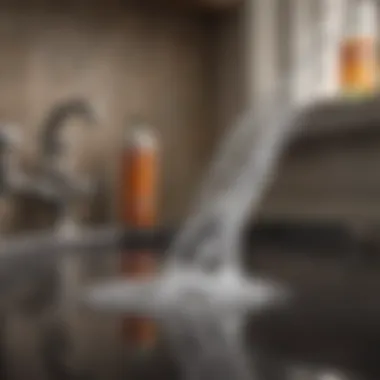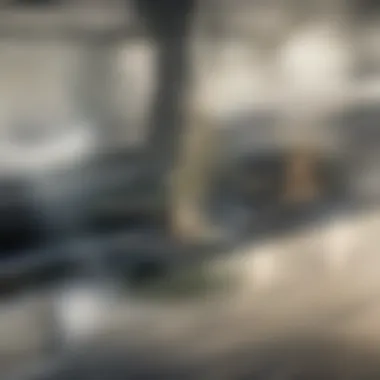Effective Ways to Clear Drains Naturally


Intro
Clogged drains can be a source of frustration in any household. When faced with this common problem, many instinctively reach for powerful chemical solutions like Drano. However, dealing with clogs doesn’t always have to involve harsh substances that can be damaging to the environment and plumbing fixtures. This article explores effective ways to tackle drainage issues without chemical products. By focusing on natural remedies and practical techniques, homeowners can find relief from clogs while also contributing to sustainable living.
Feature Spotlight
When considering alternative methods for drain clearance, it’s essential to spotlight the advantages of natural and mechanical solutions. Natural ingredients not only provide effective results but also offer several benefits over chemical options.
Exceptional Techniques
One notable approach involves using baking soda and vinegar. This combination creates a natural fizzing action that can help break down minor clogs and clear out buildup in pipes. Here’s a simple method to use:
- Pour half a cup of baking soda down the drain.
- Follow it with half a cup of vinegar.
- Cover the drain with a cloth or cap to keep the reaction focused.
- Wait 30 minutes, then flush the drain with hot water.
This technique is widely recommended and has proven beneficial for many homeowners. Not only does it help to clear drains, but it is also safe for the environment.
Unique Ingredients
Another powerful yet natural remedy is the use of salt and boiling water. Salt can help further break up grease and debris in pipes. Here’s how to apply this method:
- Boil a kettle of water.
- Pour about half a cup of salt down the drain.
- Follow quickly with the boiling water to dissolve the salt and push debris through the plumbing system.
This combination is effective in keeping drains clear over time and can prevent future clogs from forming.
Alternative Clearing Methods
In addition to natural solutions, there are physical methods that can be employed to address clogs in drains. Mechanical approaches allow for a more immediate response to obstructed water flow.
Plungers and Drain Snakes
Plungers can be effective in dislodging blockages near the drain's entrance. A classic cup plunger or a flange plunger for toilets can work well. However, if the clog is deeper in the pipes, a drain snake may be necessary. Using a drain snake involves:
- Inserting the snake into the drain.
- Turning the handle to extend the coil into the pipe.
- Once resistance is felt, continue turning to break the clog.
- Slowly withdraw the snake while continuing to turn.
This method is straightforward and can be a lifesaver for persistent clogs.
Finale
Opting for non-chemical methods to clear drains aligns well with both environmental conservation and home maintenance strategies. With a combination of natural ingredients and effective mechanical methods, homeowners can effectively manage clogged drains without resorting to aggressive chemical alternatives. Such practices not only promote sustainability but also ensure longevity for plumbing systems.
Prolusion
Draining systems are critical components in any home or building. They serve a functional purpose, yet their maintenance is often overlooked. Understanding how to manage clogged drains without resorting to harsh chemicals offers several benefits. Not only do natural remedies reduce environmental impact, they also ensure the longevity of plumbing systems. In this article, we provide insight into effective methods that are both safe and sustainable.
The absence of chemical cleaners like Drano brings into focus various practical techniques. This can encourage a more mindful approach towards home maintenance while being kind to both the plumbing and the planet. Recognizing the nuances of drain care is vital for every homeowner.
Understanding the Need for Drain Maintenance
Regular drain maintenance is crucial for preserving the functionality and integrity of plumbing systems. Clogs can develop slowly over time, often triggered by everyday activities. This accumulation can lead to more severe plumbing issues if not addressed. For instance, dirty water can lead to unpleasant odors and even potential health risks.
Being proactive in maintaining drains helps prevent inconvenient blockages. Homeowners can save both time and money by adopting proper cleaning methods early on. There are significant advantages to recognizing the underlying causes of drain problems, which range from hair and grease accumulation to food particles.
Engaging in routine inspection and cleaning reduces the likelihood of severe clogs. By understanding these factors, one can more effectively intervene before problems escalate. The goal is not solely to fix an immediate inconvenience, but to foster a sustainable relationship with home infrastructure.
"An ounce of prevention is worth a pound of cure." Let this saying guide your approach to drain maintenance. Regular checks can spare you the hassle of urgent repairs.
Common Causes of Clogged Drains
Understanding the common causes of clogged drains is essential for effective home maintenance. Clogs can lead to serious plumbing issues and costly repairs if not addressed promptly. Identifying the specific elements that lead to blockages helps homeowners to implement preventive strategies. Furthermore, recognizing these causes provides insight into proper habits and practices that can save both time and money in the long run.


Hair Accumulation
One of the most prevalent culprits behind drain blockages is hair accumulation. Hair tends to enter the drainage system from various sources, such as showers, bathrooms, and sinks. Hair tangles with soap scum, grease, and other debris, forming a dense mass that hinders water flow. Regular removal of hair from shower drains and sink traps can significantly reduce the likelihood of clogs. Consider using a drain cover or mesh screen to catch hair before it travels down the drain. This simple yet effective measure can be crucial in maintaining a clear plumbing system.
Grease Buildup
Another significant factor contributing to clogged drains is grease buildup. Cooking oils, fats, and other greasy substances often go down the kitchen sink without consideration. When these substances cool, they solidify and stick to the pipes, creating stubborn blockages. To combat this issue, avoid pouring grease down the drain. Instead, collect grease in a container and dispose of it in the trash once it cools. Running hot water mixed with soap after cooking may help to flush residual grease, but it is not a permanent solution. Regular deep cleaning of your pipes can also promote a healthier drainage system.
Food Particles
Food particles are commonly found in kitchen drains, but they can contribute significantly to clogs if allowed to accumulate. Small bits of food may not seem harmful initially, but over time, they can combine with other debris and grease, leading to a blockage. To minimize the risk, keep your garbage disposal in good condition and avoid disposing of large food remnants down the sink. Use a sink strainer to capture food particles and regularly clean it to ensure optimal drainage performance.
Foreign Objects
Lastly, foreign objects represent another cause of drain clogging. Items such as cotton swabs, feminine hygiene products, and even small toys can find their way into the plumbing system, causing significant obstructions. These materials do not break down like organic waste and can create severe blockages if not removed. Educating household members about what can and cannot be disposed of through the drains is vital. Consider placing wastebaskets in strategic locations to encourage proper disposal methods.
Regular maintenance and awareness of potential clog sources can save homeowners from extensive plumbing issues.
By understanding these common causes of clogged drains, homeowners can take proactive measures to prevent them. This awareness promotes better habits and ultimately leads to a more efficient and effective drainage system.
Preventive Measures
Preventive measures are crucial in maintaining a well-functioning drainage system. They minimize the chances of clogs, thus reducing the need for unsightly and inconvenient interventions. Implementing regular cleaning habits and utilizing protective tools can greatly enhance the longevity and effectiveness of drains.
Regular maintenance fosters good practices within the home, ensuring that even minor issues are addressed before they escalate. Aside from practicality, knowing you are preventing clogs contributes to a sense of satisfaction and peace of mind.
Regular Cleaning Habits
Regular cleaning habits are essential to prevent the accumulation of unwanted materials in your drains. Routine cleaning not only keeps the pipes clear but also helps to identify potential problems before they become serious issues. Aim to incorporate a cleaning schedule into your household routine. For example, once every month or two, dedicate time to clean all accessible drains.
Start by removing any visible debris around sink drains. Hair and soap residue often present themselves as easy targets. For kitchen sinks, dispose of any food waste properly and avoid rinsing greasy pans. A simple hot water rinse can also help break down minor build-up.
Additional steps might include:
- Using natural cleaning agents like baking soda and vinegar periodically. This method is effective and avoids harmful chemicals.
- Flushing the drains with boiling water to help maintain clear pipes.
- Checking for leaks or signs of corrosion, which can exacerbate clogging issues.
By maintaining these habits, you can increase the efficiency of your plumbing system and prolong its lifespan.
Use of Drain Guards
The implementation of drain guards can serve as a proactive stance against clogs. These protective devices catch debris before it has the chance to enter pipes. A drain guard is typically a mesh or slotted cover that sits over the drain, capturing hair, food particles, and other foreign materials.
Using drain guards is simple. Install them over sink and tub drains to catch any loose debris. They are easy to clean. Just remove, clean, and reinstall. Regularly doing this can minimize the risk of clogs.
Consider the following benefits of drain guards:
- They can significantly reduce the frequency of clogs, which often require more extensive cleaning methods.
- They save money in plumbing repairs over time.
- They promote an overall cleaner drainage system by preventing waste from entering the pipes.
Natural Solutions for Clearing Drains
Natural solutions for clearing drains present an effective, eco-friendly alternative to harsh commercial chemicals like Drano. The significance of these methods lies in their ingredients—common household items that not only cost less but also minimize environmental harm. Whether for the safety of those in the home or for the well-being of local ecosystems, natural options appeal to a growing audience concerned about sustainability.
Beyond environmental considerations, natural methods have practical benefits. Many of these solutions can be prepared using ingredients already present in your kitchen, making them both accessible and economical. Furthermore, they can reduce the risk of damaging pipes, a serious concern when using strong chemical products. This section will delve into a few practical natural remedies, each bringing unique properties to effectively address clogs in a safe manner.
Baking Soda and Vinegar Method
The baking soda and vinegar method is well-known and highly effective in tackling minor clogs. This combination works through a simple chemical reaction: when baking soda, a base, meets vinegar, an acid, they produce carbon dioxide gas. The fizzing action can help dislodge debris and buildup within the pipes.
Steps to Follow:


- Start by pouring a pot of boiling water down the drain to loosen any debris.
- Next, add half a cup of baking soda directly into the drain.
- Follow the baking soda with half a cup of vinegar.
- After a few minutes, flush the drain with more boiling water.
This method not only aids in clearing the clog but also helps deodorize the drain due to the properties of baking soda.
Salt and Hot Water Approach
A simple yet effective solution for clearing grease buildup involves using salt and hot water. Salt acts as an abrasive agent, while hot water helps dissolve oils and fats that can accumulate over time. This approach is particularly useful for kitchen sinks.
Steps to Follow:
- Heat water until it reaches near boiling point.
- Pour about a cup of salt directly down the drain.
- Finally, follow with boiling water to flush the drain.
This method is straightforward and can be repeated as a preventive measure to keep drains clear of grease.
Borax Treatment
Borax, or sodium borate, is another natural remedy that can effectively unclog drains. It has antiseptic properties and can help break down build-up caused by organic materials.
Steps to Follow:
- Begin by pouring one cup of Borax down the drain.
- Let it sit for about 15 minutes.
- Flush the drain with boiling water.
This method is particularly beneficial for recurring odors or clogs, as it not only helps clear blockages but can also neutralize unpleasant smells.
Incorporating these natural solutions into regular home maintenance routines not only enhances the efficacy of drain cleaning but also provides peace of mind regarding the health of plumbing systems.
Physical Techniques for Clog Removal
Understanding how to clear a drain without resorting to harsh chemicals is essential. Among the various methods available, physical techniques stand out for their practicality, effectiveness, and environmental friendliness. These techniques offer immediate results and are often cost-efficient. By relying on manual tools, homeowners can address clogs resulting from various substances, including hair, grease, and food particles. Moreover, the implementation of physical techniques reduces reliance on chemical solutions, contributing to a safer home environment.
Plunging Techniques
Plunging is one of the foremost physical techniques for unclogging drains. This method is straightforward yet powerful. It relies on creating pressure differences within the pipe system to dislodge clogs.
To effectively use a plunger, follow these steps:
- Select the Right Plunger: Ensure you have a cup plunger for sinks and toilets. The design is crucial for effective suction.
- Create a Seal: Position the plunger over the drain opening. It should fit snugly to create a tight seal.
- Pump Vigorously: Move the handle up and down rapidly while maintaining the seal. This action creates suction and pressure changes that can force the clog down the drain.
- Check Results: After several thrusts, lift the plunger to see if water drains properly. If not, repeat the process.
Tip: Adding a bit of water in the sink or toilet can enhance the plunging effect. It helps form a better seal.
Snake or Auger Usage
When plunging proves ineffective, using a drain snake or auger can be the next step. This tool allows you to physically reach into the plumbing and break up or retrieve the obstruction. Here’s how to effectively use these tools:
- Prepare the Area: Clear the space around the drain to ensure ease of access.
- Insert the Snake: Gently push the snake into the drain until you feel resistance. Turn the handle to help the snake move past the clog.
- Break Up the Clog: Continue to turn the snake as you push it deeper. This motion helps to break apart the obstruction.
- Remove the Clog: Once you’ve dislodged the blockage, pull the snake out slowly and clean it. Rinse the drain with hot water to ensure any remaining debris is washed away.
Chemical-Free Commercial Alternatives
In the realm of household maintenance, using chemical-free commercial alternatives for drain cleaning is a burgeoning trend. This section examines the significance of such products in the context of maintaining a clean and functional drainage system. By opting for these alternatives, homeowners can preserve both their health and the environment. Traditional chemical drain cleaners, like Drano, contain corrosive substances that can cause damage to pipes and harm aquatic life when washed away. Therefore, the adoption of eco-friendly products is vital for those looking to clear drains sustainably.
Eco-Friendly Drain Cleaners
Eco-friendly drain cleaners cater to those who seek effective solutions without compromising health and environmental safety. These products are often made from plant-based ingredients that efficiently dissolve clogs without harsh chemicals. The benefits include:
- Minimal environmental impact: They break down harmlessly in the ecosystem, protecting aquatic habitats.
- Less risk of pipe damage: Unlike conventional cleaners, eco-friendly options do not corrode pipes over time.
- Safer for households: Families with children or pets can use these cleaners without fear of accidental poisoning or skin irritation.
When purchasing eco-friendly drain cleaners, it is important to read labels and ensure the certifies effectiveness against specific clogs.
Enzyme-Based Solutions
Enzyme-based solutions provide another innovative alternative for clearing clogged drains. These cleaners employ natural enzymes and bacteria to digest organic material that causes blockages. This process is not only effective but also beneficial for the longevity of plumbing systems. Some notable aspects include:


- Targeted action: The enzymes specifically break down substances like hair, grease, and food particles, addressing the root cause of clogs.
- Non-toxic formula: As these solutions are derived from organic materials, they present minimal health risks to users and pets.
- Sustained results: Regular use can help maintain clear plumbing by preventing future buildup, thus reducing the frequency of significant clogs.
"Adopting chemical-free alternatives is not only a step toward cleaner drains, but also a commitment to a healthier planet."
By incorporating eco-friendly and enzyme-based alternatives into routine drain maintenance, homeowners can effectively manage their plumbing systems without overlooking sustainable practices.
When to Call a Professional
Engaging in drain maintenance often empowers homeowners with the skills to address minor clogs through various methods. However, some situations demand the intervention of a professional, especially when drain issues escalate beyond ordinary methods. Knowing when to seek help is vital not only for the integrity of the plumbing system but also for safeguarding personal property from potential damage.
Recognizing Serious Plumbing Issues
Several signs indicate that a plumbing problem might require professional assessment. These issues can be frustrating and could compromise the overall functionality of your home’s plumbing system. Here are some key indicators:
- Frequent Clogs: If you find yourself dealing with repeated drain blockages, it might signal a larger problem within the plumbing system that simple remedies cannot address.
- Slow Draining: When water consistently drains slowly across multiple fixtures, this often suggests a common drainage problem that necessitates expert attention.
- Unpleasant Odors: Foul smells emanating from drains may indicate trapped waste or sewage issues, which can pose health risks.
- Water Damage: Noticing moisture, stains, or mold in nearby areas can suggest a leak or backflow, prompting immediate professional evaluation.
- Changes in Water Pressure: Fluctuations in water pressure could indicate blockages or severe plumbing problems requiring specialized tools and knowledge.
If you experience any of these issues, it is prudent to consult a professional plumber. Their expertise can pinpoint the origin of the problem, utilize advanced equipment, and offer long-lasting solutions tailored to your specific situation.
"Timely professional intervention can prevent small plumbing issues from escalating into major repairs, saving both time and financial resources."
Considering the ramifications of neglecting these signs is crucial. Homeowners may take risks by attempting to resolve complex plumbing issues themselves. This can exacerbate conditions, leading to costly repairs and extensive damage. Therefore, prioritizing professional consultation when necessary contributes to maintaining a well-functioning home environment.
Maintaining Aesthetic Integrity While Addressing Drains
Maintaining the aesthetic integrity of your home while addressing drainage issues is essential for both functional and visual appeal. Drain covers and systems often sit in plain view, and they can detract from the overall ambience of a space if not chosen wisely. A beautiful home deserves a clean and attractive appearance, and drains do not have to undermine this objective.
When considering the aesthetic aspects of drain maintenance, it is important to choose materials and designs that complement the existing decor. This will not only enhance your home's visual appeal but also reinforce the notion that practical solutions can seamlessly blend into the environment. By selecting suitable options, homeowners have the potential to improve the look and functionality of their drainage systems without sacrificing design.
Selecting Visually Pleasing Drain Covers
Drain covers are one of the most noticeable parts of a drainage system. Opting for visually pleasing designs can significantly elevate the overall look of the space. Here are a few considerations when selecting drain covers:
- Material Selection: Materials such as stainless steel, copper, and decorative cast iron provide durability while also enhancing aesthetic appeal. These materials can resist corrosion, ensuring longevity and maintaining a polished look.
- Design Variety: There are multiple styles available, from simple, minimalistic designs to more ornate and artistic patterns. Choose a design that fits not only your personal taste but also the style of your home.
- Customization Options: Some manufacturers offer customized drain covers that can be made to match specific themes or colors in your home. Personalized solutions contribute both to functionality and uniqueness.
By prioritizing visual appeal in drain covers, homeowners enhance the look of their interiors and exteriors, ensuring that necessary features blend harmoniously into their overall design.
Incorporating Natural Materials
Incorporating natural materials into drain maintenance can bridge the gap between functionality and aesthetic enjoyment. Using stones, wood, or even crafted ceramics for drain covers and systems can create a more inviting atmosphere and resonate with nature.
- Stone or Pebble Drain Covers: These offer a rustic charm and can integrate well with outdoor spaces. They can be designed to fit naturally into gardens, enhancing the landscape.
- Wooden Drain Solutions: While durability is a concern, treated and sealed wooden designs can offer warmth and texture to a space. They can work particularly well in eco-conscious homes or those wishing to emphasize organic elements.
- Ceramic or Earthy Designs: These materials can add a touch of elegance while still being functional. Artisanal designed pieces can reflect personal style and elevate the drainage areas of your home.
Integrating aesthetic integrity in drainage systems does not just improve the looks; it also reflects careful thought about how different comforts can coexist in harmony.
Investing in maintaining the visual appeal of your home's drainage system proves that functionality doesn’t have to compromise design. Homeowners benefit from a cleaner, more attractive setup that speaks to both the practical and aesthetic aspects of home maintenance.
Ending
In any discussion about drain maintenance, the conclusion holds significant importance. This section serves to reaffirm the main points presented throughout the article and emphasizes the need for a proactive approach to clear clogged drains. Readers are encouraged to adopt natural and effective methods that have been highlighted, enhancing their understanding of sustainable practices.
Recap of Effective Methods
To achieve clear drains without harsh chemicals, several methods have been presented:
- Baking Soda and Vinegar Method: This is a cost-effective solution that employs a chemical reaction to break down debris.
- Salt and Hot Water Approach: This method uses simple household items that are powerful enough to dissolve greasy buildups.
- Borax Treatment: Borax is another household product that can break clogs effectively, especially when used in combination with hot water.
- Plunging Techniques: A plunger can help dislodge blockages with physical force, making it a practical and immediate solution.
- Snake or Auger: These tools allow for deep cleaning, reaching areas where standard methods might fail.
- Eco-Friendly Drain Cleaners and Enzyme-Based Solutions: These commercial alternatives provide safe options that are less harmful than traditional chemical cleaners.
Each of these methods is simple and emphasizes the importance of regular maintenance and preventive care.
Future Considerations in Home Maintenance
Home maintenance extends beyond mere patchwork solutions for issues like clogged drains. It involves establishing best practices that provide long-term sustainability and efficiency. Homeowners should consider the following:
- Regular Inspection: Schedule regular checks of drainage systems to identify potential issues before they escalate.
- Education on Preventive Measures: Learning what materials can lead to clogs can help mitigate future problems.
- Investing in Quality Drain Covers: Selecting covers that blend aesthetics with functionality can beautify spaces while improving drainage performance.
- Research Green Alternatives: As environmental consciousness grows, seeking out eco-friendly materials and methods for home maintenance will become increasingly crucial.
By embracing these proactive approaches, homeowners can ensure that they maintain not only their drains but also the overall quality and aesthetic integrity of their homes.







